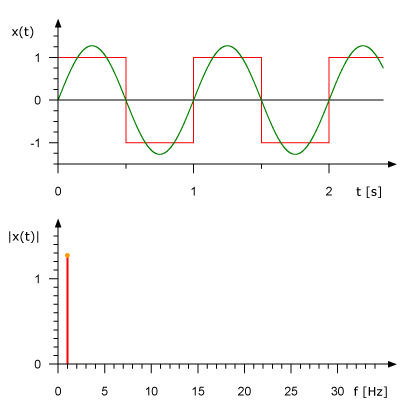Geophysics can get a little fancy.
You have probably heard the geophysicists tend to hang around some mathematicians. When it comes to the topic of math most of my friends like to state: “I was good at math until they started mixing in the alphabet!” I hear ya. Complex numbers and pi and variables are something you have to wrap your head around. However, once you let lose a mathematician there’s nothing that can stop him. No doubt the outcome can be very very useful, however you do have to – once again – wrap your head around it.
Beyond what we see
When we acquire seismic data, we tend to do this in space and time. Pretty easy. We live, sleep, eat in space and time, so it’s as intuitive as it gets right there. However, this domain X-T, X stands for space and T stands for time, has its limitations.
This marks the start of a couple of posts about different “fancy” domains, we use in geophysics.
Frequency domain
In 52 things you should know about geophysics Mostafa Naghizadeh wrote an article about “The Magic of Fourier”Hall, Matt, and Evan Bianco, eds. 52 Things You Should Know About Geophysics. Agile Libre, 2012.. Where he gives his interpretation to the single most influential mathematical idea in modern technology. As he put it:
No one can deny the great role that the Fourier transform has played in telecommunications, the electronics industry, and signal processing methods over the past century.
There is no denying that this also applies to the geophysics industry. As a geophysicist you get very used to this transform and hence its domain. Nevertheless, wenn you’re new to the game, it takes a bit of practice to look at Fourier transformed data.
(Quote is CC-BY)
The Fourier transform can be used to analyze the frequency content of a signal. This is done in a very elegant way. In principle you take different Sine waves with different frequencies and try to reconstruct your seismic signal with these. Based on the contribution a wave with a certain frequency in this reconstruction has, you get the strength of this frequency in the original signal.
How it works
The Fourier transform really gained momentum with the introduction of Fast Fourier Transform algorithmsJames W. Cooley, John W. Tukey: An algorithm for the machine calculation of complex Fourier series. In: Math. Comput. 19, 1965, S. 297?301.. These enable us to compute the Fourier spectrum in very short time. You only need a regularly sampled signal with a number of samples that is equal to a power of 2. Now this isn’t always the case. But the nice thing is that we can pad our signal with zeros up to the next power of two.
Take a look at this equation:

It’s not really that fancy. It’s just an integral. This one is the one I learned and the one I found on Wikipedia, however, you might stumble upon different factors in front of your integral. This is basically due to a difference in the norm used to define the transformation.
One very nice trait of the Fourier transformation is the ability to do an inverse transformation as well. So you can just get your signal back from the Fourier spectrum and it’s really just as easy:

Once again this one isn’t uniform across the sciences, since the factor in front of the integral can differ. This once again depends on the definition of the transformation. Nevertheless, these two work and have a couple nice traits, which other definitions don’t.
This integral, like any other integral won’t work on a computer. Or better, won’t work in any reasonable way. What we can do, however, is discretize it and feed it to our numbercruncher.

This sum is solvable on a computer, now if we make some improvements, some smart people suggested, we can actually solve this one really fast.
Where it excels
The major advantage of their method is its speed. You can get an overview about the frequency content within no time. Especially, the old days could really profit from a Fourier transformation. Seismic data is pretty much all about oscillation and as you might remember from physics class, oscillations can be written down as differential equations. These can get pretty tough to compute, but if we can break them down into algebraic functions we can really make it easy on ourselves.
Also the frequency content of our data can reveal a lot of information about the data we use. This information will not be clearly visible in the time domain.
Resolving our data in harmonic oscillations is the basis for many other transformations we can utilize in geophysics.
Where it falls short
When viewing our data in the time domain we cannot resolve the frequency content. After transformation into the frequency domain, the time resolution will not be visible. We are working with time-variant signals, so when we transform into the frequency domain, we do not account for time-variance. We obtain the frequency content of the complete data set without a distinction of frequency changes over time.
Another trait we have to be aware of and treat with caution would be sharp edges. A sharp edge like the top hat function in the image above will introduce artifacts, we really do not want. Usually we choose an approach to smoothen the edges in our data, as well as the margins of our data set.
This isn’t a disadvantage of the process itself but something we need to be aware of. When analyzing the frequency content of data, we should always be aware that a violation of the Nyquist-Shannon theorem in the acquisition phase will very likely have introduced apparent frequencies into the data that aren’t actually there. In that case we can trash the data.
An example
The Stanford Exploration Project has some very nice educational resources. Here, they take a look at a single dipping reflector and it’s FX Domain.
We want to preserve our data as good as possible, so we certainly need to preserve the frequency content as good as possible. However, if we want to get rid of artifacts, we certainly need to manipulate our data. In fact we can eliminate nose by altering the frequency spectrum (i.e. FX Deconvolution).
In geophysics, we make a distinction between a column-wise 1D Fourier analysis and a 2D Fourier analysis. The 1D Fourier transformation will show the frequency content at every spatial coordinate. The 2D Fourier transformation will also transform the spatial coordinate and give yet another set of information. The 2D Fourier transformation will be the topic of another post in the fancy domain series.
Common Uses
Common uses in geophysics range from the acquisition the final migration stage. The magic of Fourier sums these uses up very well, have a read into it.
A first look into the frequency content will give you a good clue on how to handle the data. Also when I work with my data a FX Deconvolution is pretty standard. Many other processes used in seismic data processing are based on a Fourier transformation.
What are some common uses you have for the frequency domain?
Jesper Dramsch
Latest posts by Jesper Dramsch (see all)
- Juneteenth 2020 - 2020-06-19
- All About Dashboards – Friday Faves - 2020-05-22
- Keeping Busy – Friday Faves - 2020-04-24




